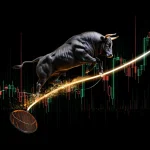Editor: Vladimir Bajic | Tactical Investor
Why Do Economists Study the Money Supply? They’re Not Even Sure
April 4, 2025
Introduction The Slow Knife: When Lower Rates Whisper Before Inflation Roars
Imagine a room filled with gas—no sound, no spark, only potential. That’s the economy in the early stages of monetary easing—a subtle hum of lower interest rates. The central banks speak in soft tones, markets rejoice, asset prices soar, and yet the floor beneath begins to liquefy. Most don’t notice. They never do—not until the spark.
An increase in the money supply is not an explosion. It’s a seduction. Lower rates ease credit, pump liquidity, and stoke leverage. It feels like prosperity until it mutates. Investors intoxicated by risk-on environments fail to see the rot beneath the rally. The early phase of monetary expansion is not where the danger lies—but where it is concealed.
Dynamic Clarity: What the Models Miss, the Mind Must Grasp
Traditional economists chant their mantras: money supply up, inflation lags. True. But too many fixate on sequence and miss the transformation. The real game isn’t in the lag—it’s in the behavioral shifts sparked before the CPI even flinches.
Low rates alter risk calculus. They incentivize malinvestment, foster zombie firms, and inflate bubbles—subtly but systemically. The mispricing of time and capital begins here—not when inflation prints 6%, not when politicians hold press conferences, but when rate cuts are hailed as a victory lap, not a warning shot.
This is the vector space of policy impact: not linear cause and effect but a tangle of feedback loops, sentiment swings, and liquidity surges that first distort perceptions before they devalue purchasing power. Central banks use models, but human markets move like herds—sensitive to tremors, not timelines.
Contrarian Passion: Inflation Doesn’t Knock, It Kicks the Door Down
Inflation doesn’t arrive politely. It doesn’t RSVP. It crashes the party when confidence in control becomes gospel. That’s the irony—central bank success in soothing panic lays the groundwork for its next failure.
By the time inflation arrives visibly, the groundwork has been laid: supply chains are already warped, demand is artificially stoked, and speculative capital is bloated. The tragedy? Most of the crowd still believes the narrative of control. They think rate hikes will “fix it.” They believe in soft landings.
Contrarians, meanwhile, move early. They don’t wait for CPI. They read the flow of capital, the distortions in yield curves, the froth in asset valuations. They move when liquidity surges—not because prices scream inflation but because the conditions for stealth devaluation are now in place.
The Finesse of Fire: Inflation Is a Psychological Event First
Price increases are a symptom; the disease is expected. Once the collective mind begins to price in future inflation, the game changes. Workers demand more, and businesses front-load pricing. Bond vigilantes stir.
This is not just about printed money. It’s about velocity, sentiment, and faith. The faith that money will hold its value. The velocity of money—how quickly it changes hands—is not driven by spreadsheets but by psychology.
Psychology flips faster than any model can predict.
Quantum Moves: Liquidity Is Not Neutral
Liquidity is never neutral. Injecting capital into a system isn’t like pouring water into a glass. It’s more like adding voltage to a living circuit. Its path depends on existing feedback loops, fears, and biases. It rushes toward opportunity but also illusion.
In this way, new money doesn’t just stimulate; it rearranges. It inflates assets, distorts price signals, and, most dangerously, makes investors feel safe. That safety breeds fragility.
Just as vector thinking allows AI to see beyond literal associations, investors must learn to interpret liquidity as a stimulus and a signal of regime change.
Outliers Win: The Smart Money Moves Precursor to Chaos
The world thinks in linear steps: A leads to B, which leads to C. But that’s not how markets operate. They move in anticipation, lurch in clusters, and invert logic.
That’s why the best investors don’t wait for textbook signs. They act when the backdrop shifts—from organic growth to artificial stimulus, rational pricing to emotional exuberance.
When rates drop and money floods the system, they begin watching—not celebrating. They analyze where the money is going, how fast it’s moving, and whether the crowd is mistaking euphoria for stability.
The Art of Anticipation: Watch the First Derivatives
Forget lagging indicators. What matters is acceleration. Not just where prices are—but how quickly they’re changing. Look at the slope. Look at the momentum behind credit growth, wage pressure, and raw input prices.
Inflation hides in rate-of-change before it screams in headlines.
And here’s the real key: The smart players use this window—the period between liquidity injection and headline inflation—to reposition, exit bubbles, rotate capital, and hedge against what the public still thinks is impossible.
Danger in Disguise: When Prosperity Feels Too Easy
The initial surge in asset prices from lower rates feels like a reward. But it’s bait. It lures capital into risk, amplifies leverage, and tempts policymakers to believe in their omnipotence.
It’s the illusion of control that breeds the deepest crisis. When they realize inflation is embedded, the policy toolkit is already compromised. Rates are too low to cut. Debt is too high to absorb shock. And public trust? On the brink.
Final Thoughts: The Money Mirage and the Masterstroke
An increase in the money supply doesn’t shout—it murmurs beneath the surface, like a predator circling in silence. When the crowd hears the roar, it’s already too late. The beast has moved on, and the easy prey has been consumed.
The shrewd investor doesn’t chase noise or surface-level signals. They track the silent shifts—liquidity pulses, policy pivots, credit expansion—which are the real tremors before the quake. While the majority fixates on CPI prints and central bank chatter, the cunning ones are already positioned, having read the change in tempo before the dance began.
Understanding money supply isn’t about knowing what happened—it’s about sensing what must happen next. Because markets don’t move on truth; they move on perception, liquidity, and timing. And those who master that triad? They don’t just survive. They feast.
So while the textbooks debate definitions, the real players are rewriting outcomes—not by studying the mirage but by owning it.













